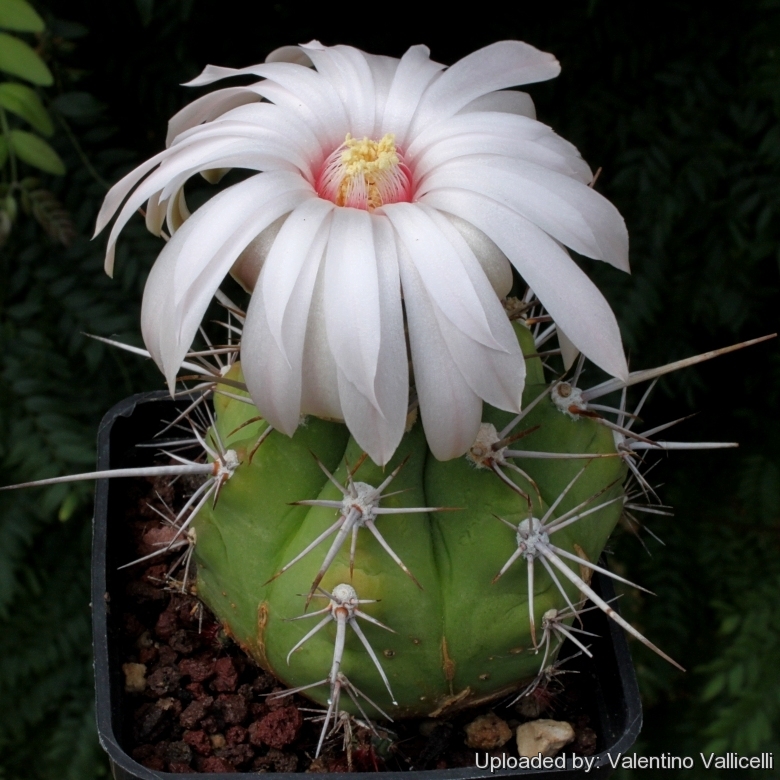
Gymnocalycium paediophilum Photo by: Valentino Vallicelli
Origin and Habitat: Cerro Leon, Boqueron department, Alto Paraguay, Paraguay. (Southern South America, Southern America)
Altitude: 220-270 metres above sea level.
Habitat: It grows exclusively on top of a mound on the Cerro Leon in slopes between rocks of quartz through the brushwood, never in the plain. This habitat is a completely isolated relic site.
Synonyms:
See all synonyms of Gymnocalycium paediophilum
Description: Gymnocalycium paediophilumSN|33078]]SN|17825]] is a small pale green globular cactus. It is a heavy clumper related to both Gymnocalycium chiquitanumSN|26064]]SN|26064]] (flowers and seeds) and Gymnocalycium chacoenseSN|17825]]SN|33078]](seeds).
Stems: Depressed globose to shortly cylindrical, dull, light to dark green about 5-8(-12) cm diameter and 10-20 tall and branching profusely from the base.
Ribs: Mostly 7, occasionally up to 10, up to 26 mm hight, rounded, more pronounced in old plants ans slightly tubercled.
Old plants have a crosswise bulge above the areole.
Radial spines: 5-9, needle-like, awl shaped, straight, the lower ones often longer, up to 30 mm long, reddish brown, later grey with a brownish tip.
Central spines: One, stout, pungent, rigid, 1,5-2,5(-4) cm long, sometimes with 2-3 additional shorter and thinner ones, grey with a darker brownish tip, rarely completely grey. The spines have a rough surface.
Flowers: White to pale pink with reddish throat, 4,5-6(-8) cm long, 5-6(-8) cm in diameter at anthesis. Buds cream-coloured to yellowish. Pistil and stigma-lobes pink (not white). Filaments pink spreading across the base of the flower. Basal filaments adpressed against the style, uppermost ones protruding above the style.
Blooming season: Mid summer.
Fruits: Oval to spherical 5-18 mm long, 5-15 mm in diameter, green to blue-green with pinkish scales and juicy. When ripe, the fruit splits open lengthwise and the pulp is white.
Seeds: 0,7–1 mm long and up to 0,8 mm wide. Testa dark reddish brown to black, finely tuberculate. The area of the hilum is oval, whitish and has a small border fringe.
Seed group: Subgenus Microsemineum Schütz.
Remarks: There is some question as to the correct spelling of the epithet paediophilum (paidion – child, philos – friend); Ferdinand Plesnik (1977) lists it as paediophylum and Hunt (1999) lists it as pediophilum.
Subspecies, varieties, forms and cultivars of plants belonging to the Gymnocalycium paediophilum group
 Gymnocalycium chacoense Amerh.: has smaller white to pink flowers. The spines are finer, golden-yellow, denser and bristly. Distribution: Bolivian department of Santa Cruz on the island of Cerro San Miguel, 800 m asl.
Gymnocalycium chacoense Amerh.: has smaller white to pink flowers. The spines are finer, golden-yellow, denser and bristly. Distribution: Bolivian department of Santa Cruz on the island of Cerro San Miguel, 800 m asl. Gymnocalycium paediophilum F.Ritter: Distribution: Cerro Leon, Boqueron department, Alto Paraguay, Paraguay. 220-270 m asl.
Gymnocalycium paediophilum F.Ritter: Distribution: Cerro Leon, Boqueron department, Alto Paraguay, Paraguay. 220-270 m asl.
Bibliography: Major references and further lectures
1) Ritter, F. “Kakteen in Südamerika. Vol. 2. Argentina/Bolivia.” 1980.
2) James Cullen, Sabina G. Knees, H. Suzanne Cubey "The European Garden Flora Flowering Plants: A Manual for the Identification of Plants Cultivated in Europe, Both Out-of-Doors and Under Glass" Cambridge University Press, 11/Aug/2011
3) David R Hunt; Nigel P Taylor; Graham Charles; International Cactaceae Systematics Group. "The New Cactus Lexicon" dh books, 2006
4) Edward Anderson “The Cactus family” Timber Press, Incorporated, 2001
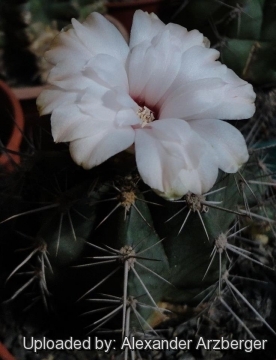 Gymnocalycium paediophilum Photo by: Alexander Arzberger
Gymnocalycium paediophilum Photo by: Alexander Arzberger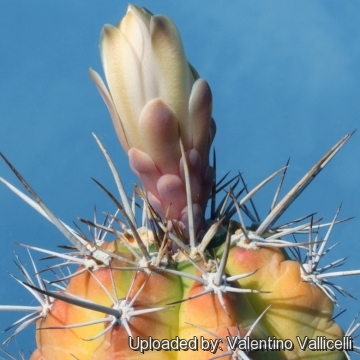 Gymnocalycium paediophilum Photo by: Valentino Vallicelli
Gymnocalycium paediophilum Photo by: Valentino Vallicelli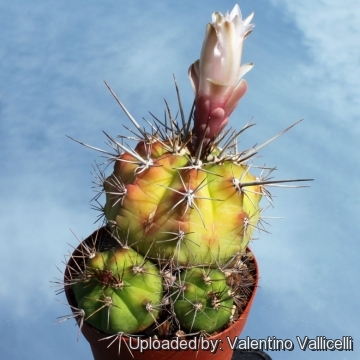 Gymnocalycium paediophilum Photo by: Valentino Vallicelli
Gymnocalycium paediophilum Photo by: Valentino Vallicelli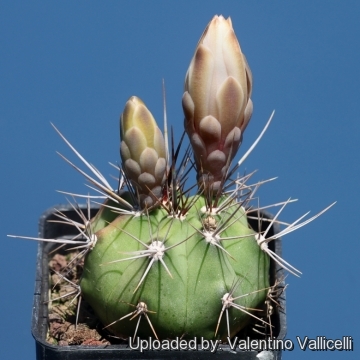 Gymnocalycium paediophilum Photo by: Valentino Vallicelli
Gymnocalycium paediophilum Photo by: Valentino Vallicelli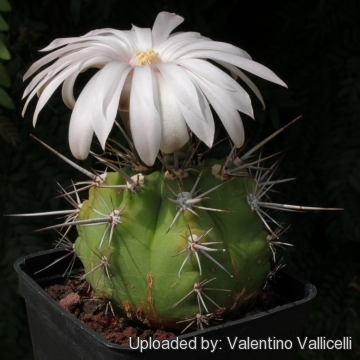 Gymnocalycium paediophilum Photo by: Valentino Vallicelli
Gymnocalycium paediophilum Photo by: Valentino VallicelliSend a photo of this plant.The gallery now contains thousands of pictures, however it is possible to do even more. We are, of course, seeking photos of species not yet shown in the gallery but not only that, we are also looking for better pictures than those already present.
Read More... Cultivation and Propagation: Gymnocalycium paediophilumSN|17825]]SN|17825]] is a summer grower species that is easy to cultivate.
Growth rate: It is a relatively rapidly growing and easily flowering species that will make clumps given the best conditions.
Soils: It likes very porous standard cactus mix soil. Prefer a low pH compost, avoid substrata rich in limestone; otherwise growth will stop altogether.
Repotting: This plant needs plenty of space for its roots, repotting should be done every other year or when the it has outgrown its pot. Use pot with good drainage.
Watering: Needs moderate to copious waterings in summer, but do not overwater (Rot prone), keep dry in winter at a minimum temperature of 0°C.
Fertilization: Feed with a high potassium fertilizer in summer.
Hardiness: Reputedly resistant to frost if kept on the dry side prior to, and during, cold weather (hardy to -5 C ° C, or less for short periods).
Exposition: The plant tolerates extremely bright situations but enjoys filtered sunlight or afternoon shade, inside it needs bright light, and some direct sun. Tends to bronze in strong light, which encourages flowering and heavy spine production, but is likely to suffer from sun scorch or stunted growth if over exposed to direct sunlight during the hottest part of the day in summer.
Uses: It is an excellent plant for container growing. It always looks good and stays small. It look fine in a cold greenhouse and frame or outdoor in a rockery.
Pests & diseases: It may be attractive to a variety of insects, but plants in good condition should be nearly pest-free, particularly if they are grown in a mineral potting-mix, with good exposure and ventilation. Nonetheless, there are several pests to watch for:
- Red spiders: Red spiders may be effectively rubbed up by watering the plants from above.
- Mealy bugs: Mealy bugs occasionally develop aerial into the new growth among the wool with disfiguring results, but the worst types develop underground on the roots and are invisible except by their effects.
- Scales: Scales are rarely a problem.
- Rot: This species is particularly easy and accommodating, seldom suffer of cryptogamic diseases. Rot it is only a minor problem with gymnocalyciums if the plants are watered and “aired” correctly. If they are not, fungicides won't help all that much.
Propagation: Division, direct sow after last frost. Seeds germinate in 7-14 days at 21-27° C in spring, remove gradually the glass cover as soon the plants will be well rooted (ca 1-2 weeks) and keep ventilated, no full sun for young plants! To make a cutting twist off a branch and permit it to dry out a couple of weeks, lay it on the soil and insert the stem end partially into the soil. Try to keep the cutting somewhat upright so that the roots are able to grow downward.
















